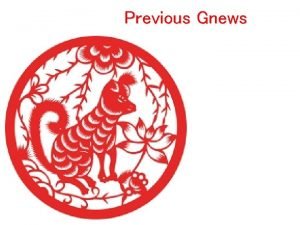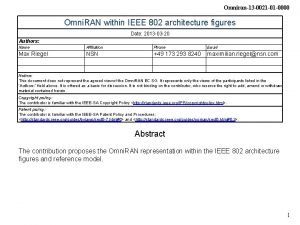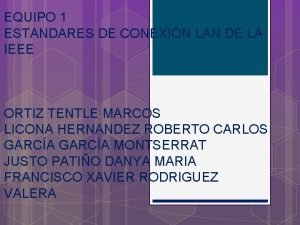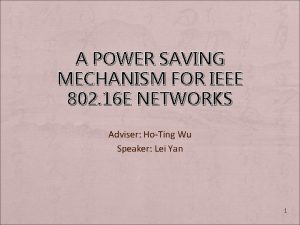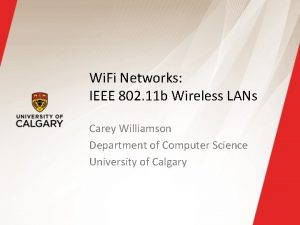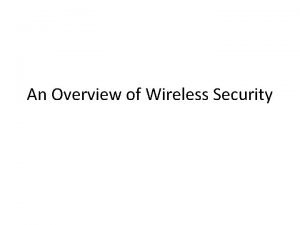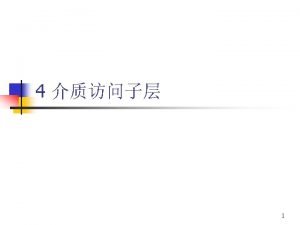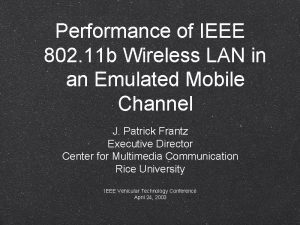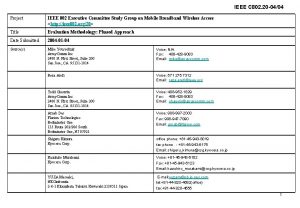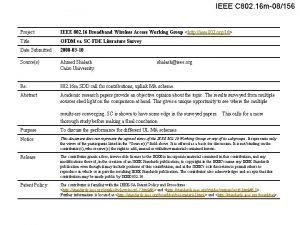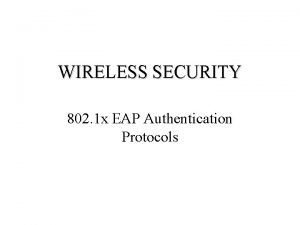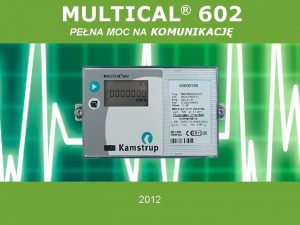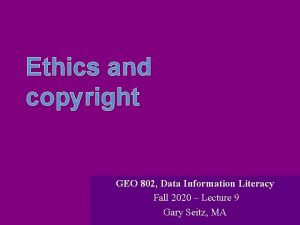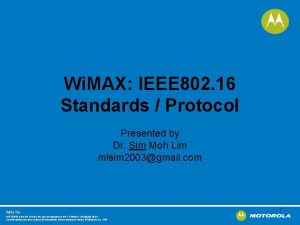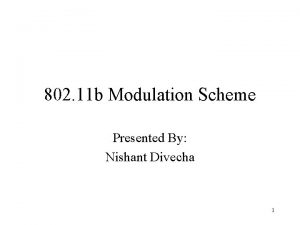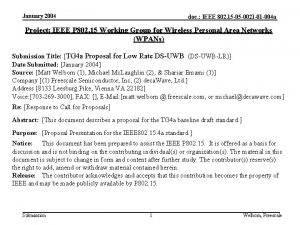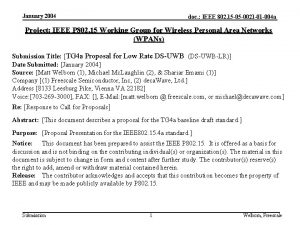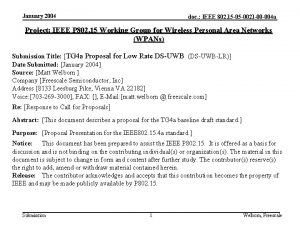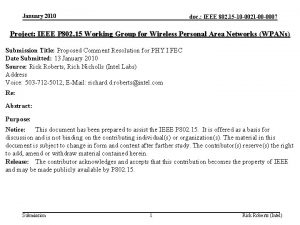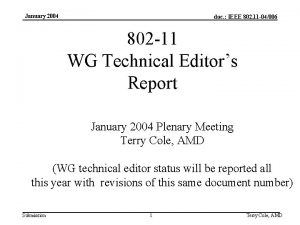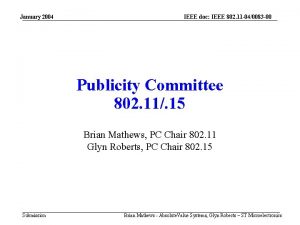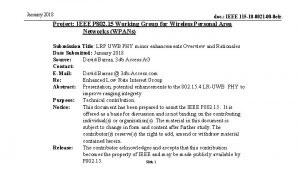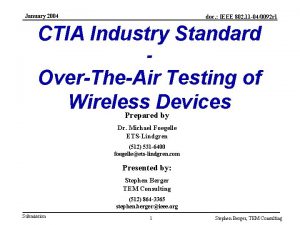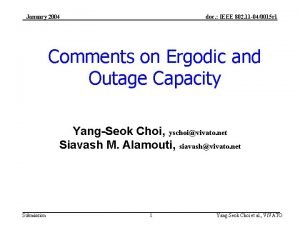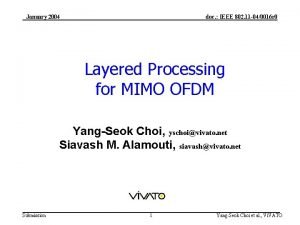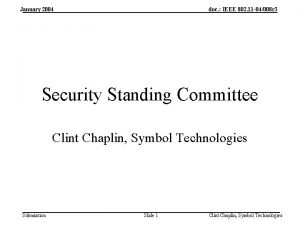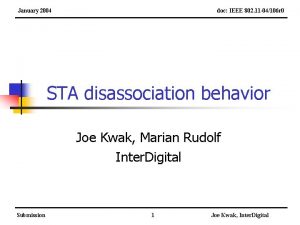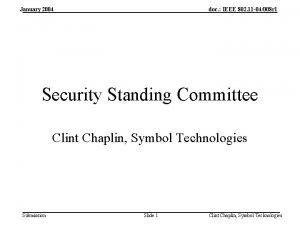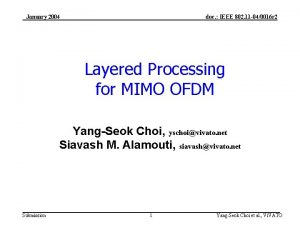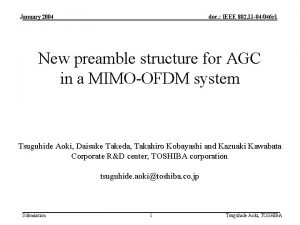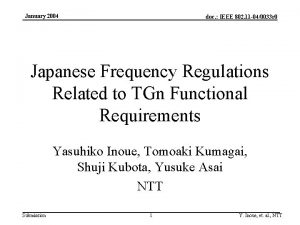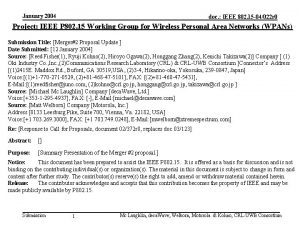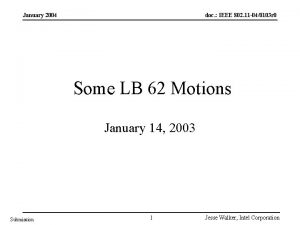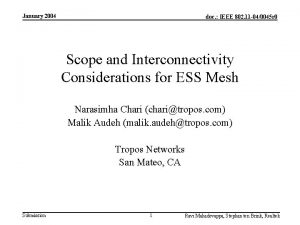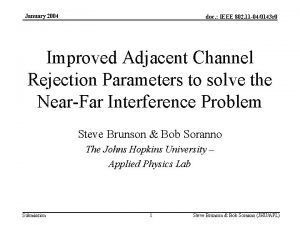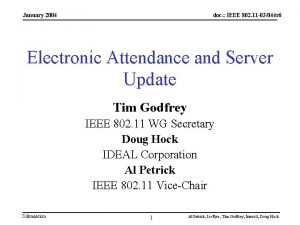January 2004 doc IEEE 802 15 05 0021


























- Slides: 26

January 2004 doc. : IEEE 802. 15 -05 -0021 -01 -004 a Project: IEEE P 802. 15 Working Group for Wireless Personal Area Networks (WPANs) Submission Title: [TG 4 a Proposal for Low Rate DS-UWB (DS-UWB-LR)] Date Submitted: [January 2004] Source: [Matt Welborn (1), Michael Mc. Laughlin (2), & Shariar Emami (1)] Company [(1) Freescale Semiconductor, Inc, (2) deca. Wave, Ltd. ] Address [8133 Leesburg Pike, Vienna VA 22182] Voice: [703 -269 -3000], FAX: [], E-Mail: [matt. welborn @ freescale. com, or michael@decawave. com] Re: [Response to Call for Proposals] Abstract: [This document describes a proposal for the TG 4 a baseline draft standard. ] Purpose: [Proposal Presentation for the IEEE 802. 15. 4 a standard. ] Notice: This document has been prepared to assist the IEEE P 802. 15. It is offered as a basis for discussion and is not binding on the contributing individual(s) or organization(s). The material in this document is subject to change in form and content after further study. The contributor(s) reserve(s) the right to add, amend or withdraw material contained herein. Release: The contributor acknowledges and accepts that this contribution becomes the property of IEEE and may be made publicly available by P 802. 15. Submission 1 Welborn, Freescale

January 2004 doc. : IEEE 802. 15 -05 -0021 -01 -004 a UWB for Low Rate Communications • UWB has great potential for low power communications – Low fading margin can provide same range for lower transmit power – Large (ultra-wide) bandwidth can provide fine time resolution provides potential for accurate ranging – primary differentiation from existing 15. 4 capabilities • Drawbacks due to regulations – Limited transmit power – how much is enough? • Operation at long ranges is highly dependent on NLOS path loss characteristics Submission 2 Welborn, Freescale

January 2004 doc. : IEEE 802. 15 -05 -0021 -01 -004 a Proposal for TG 4 a Alternate PHY Layer Submission 3 Welborn, Freescale

January 2004 doc. : IEEE 802. 15 -05 -0021 -01 -004 a Overview of DS-UWB-LR TG 4 a Proposal • Based on higher rate DS-UWB proposal under consideration in TG 3 a, but modified for low power and lower complexity – – • Variable-length code spreading with BPSK modulation of data Chip rates are 1/3 the rates used in DS-UWB (so about 450 MHz) Bandwidth is only ~500 MHz (instead of ~1500 M) Lower complexity FEC convolutional code (constraint length k=4) Data rates of 30 kbps to 10 Mbps – Use spreading codes of length 24 to 6144 – AWGN range of 15 to 75 meters (assuming n=3. 5 PL at > 10 m) • Support for precise ranging – Very straight forward solutions using RTT measurements with corrections for nondirect-path propagation effects • Flexible pulse shaping – Allows many pulse generation, antenna and receiver architectures – Supports requirements for coexistence & regulatory constraints • Will enable interoperation between higher rate DS-UWB devices and low rate, low complexity TG 4 a devices – Support wider range of asymmetric applications – Enables active coexistence and coordination Submission 4 Welborn, Freescale

January 2004 doc. : IEEE 802. 15 -05 -0021 -01 -004 a Benefits of Low Rate DS-UWB • Bandwidth & operating frequency – Transmit power, ranging, complexity & performance • Pulse rate – Effects on efficiency & implementation • Data Rate • Interoperability & Coexistence Submission 5 Welborn, Freescale

January 2004 doc. : IEEE 802. 15 -05 -0021 -01 -004 a Operating Frequency • If multiple bands used: – Multiple operating channels with different center frequencies to provide FDM operation for different networks • • Three piconet bands at 3536, 4056, and 4576 MHz Different performance due to 20 Log 10(Fc) term in path loss – Also uses CDM for sharing of each band by different piconets • Could also use pure CDM in a single wider band – Could even mix wider band devices (1500 MHz) and narrower band devices (500 MHz) • Cost of generating the reference frequency depends on the specific frequency – DS-UWB is based on low cost, high quality 26 MHz crystals (widely used in cell phones) • Better frequency accuracy can relax other system constraints – Acquisition at longer range requires longer integration and therefore more accurate reference frequency – High accuracy clock can allow longer “sleep” time & better power management – Precise ranging using TOA methods requires high precision time measurements over relatively long intervals (RTT) to determine small differences in signal propagation times • Submission Simplified and improved with good reference clock 6 Welborn, Freescale

January 2004 doc. : IEEE 802. 15 -05 -0021 -01 -004 a Signal Operating Bands for Low Rate UWB Relative PSD (d. B) Possible Lower Rate Signaling Bands (500 MHz bandwidth) High rate DS-UWB Low Band with RRC Pulse Shape 0 -3 FCC Mask -20 3536 4056 3100 4576 5100 Frequency (MHz) • Ultra-wideband ~500+ MHz bands for each piconet – Code-division and Frequency-division multiplexing – Multiple piconets in each band using different codes • Operation in close proximity, interference avoidance or coexistence • Three piconet bands at 3536, 4056, and 4576 MHz Submission 7 Welborn, Freescale

January 2004 • • doc. : IEEE 802. 15 -05 -0021 -01 -004 a Low Rate DS-UWB Pulse Rate “Impulse radio” (IR) originally meant low pulse rate (10’s of M pulse/sec) using “time hopping” for multiple access and pulse position modulation (PPM) More generally, IR is just pulse-based spread spectrum with data modulation – Many choices for modulation (BPSK, PPM, OOK, etc. ) – One or more pulses per data symbol • Low rate DS-UWB uses a chip rate that is designed to meet minimum 500 MHz bandwidth for simple BSK modulation – Center frequency is always a multiple of 26 MHz – Chip rate is equal to center frequency divided by 9 (e. g. 4052 / 9 = 450. 66 MHz) – Spreading codes are based on 24 -chip code – Longer spreading codes are derived from the basic code by further sreading with PN sequence (e. g. length 192 code is a length 24 code spread by a length 8 PN code) • • Pulse rate does not fundamentally affect transmit power, signal bandwidth or system performance Pulse rate does affect energy per pulse and therefore peak power (and voltage) Submission 8 Welborn, Freescale

January 2004 doc. : IEEE 802. 15 -05 -0021 -01 -004 a Higher Pulse Rate = Lower Peak Power Higher peak power & voltage for same average power • Lower pulse rate requires higher “energy per pulse” and therefore higher peak power (and voltage) for same transmit power • Process technology can limit available peak voltage that can be achieved without an external power amplifier ___ • If pulse rate is 100 x slower, then peak voltage is 100 = 10 x higher Submission 9 Welborn, Freescale

January 2004 doc. : IEEE 802. 15 -05 -0021 -01 -004 a Something Special about Impulse Radio • For impulse radio, basic idea was to send a fixed pulse shape at a regular (or controlled) interval • For conventional carrier systems, the “pulse shape” at RF is not fixed due to lack of fixed relationship between carrier phase and symbol clock phase • Result: if properly designed we can have combine the benefits of conventional carrier-based systems and impulse systems – Fixed phase relationship between carrier & symbol • DS-UWB is based on integer relationship between center frequency (carrier) and chip or symbol rate – Makes frequency synthesis and implementation easier Submission 10 Welborn, Freescale

January 2004 doc. : IEEE 802. 15 -05 -0021 -01 -004 a No Advantage to Non-Coherent Given that synchronization to chipping clock must be done regardless, and Since RF is easily synchronized to the chipping clock, There is no reason not to build coherent systems Chipping Clock Must Be Synchronized Regardless of Coherent/Incoherent Approach + Ring Oscillator + Simple injection lock or PLL No jitter issues because of high BW (only 3 X multiply) A very small ring oscillator at 4. 1 GHz Injection lock or PLL an LC oscillator Submission Ring-up a filter to create an RF UWB pulse 11 Welborn, Freescale

January 2004 doc. : IEEE 802. 15 -05 -0021 -01 -004 a Data Rate Considerations • Lowest PHY data rate does not necessarily mean lowest energy consumption • In fact, a fast radio can potentially be more energy efficient than a slow radio. Example: – Compare a 1 Mbps radio at 100 m. W versus 10 kbps radio at 10 m. W – 32 k. B @ 10 kbps = 0. 256 m. W*seconds – 32 k. B @ 1 Mbps = 0. 0256 m. W*seconds – 1/10 of the energy per bit! • Assumptions – Both radios achieve minimum range requirement for application – Minimum acquisition time is a function of SNR (range) not data rate – Requires fast wake-up and shut down of radio with aggressive power management • Relative energy usage depends on packet size – Fast radio advantage is higher for longer packets • Notice transmit power is a small fraction of the total power (<1%) – The largest power use is turning on the radio and processing signal Submission 12 Welborn, Freescale

January 2004 doc. : IEEE 802. 15 -05 -0021 -01 -004 a Data Rate Considerations Lower radio power, but longer transmission time for data payload Power Preamble Time Higher peak power but shorter transmission time for same payload Power Preamble Time • Total energy use from battery is the “area” under the power vs. time curves shown above • Relative efficiency depends on power & duration (payload size) Submission 13 Welborn, Freescale

January 2004 doc. : IEEE 802. 15 -05 -0021 -01 -004 a Low Rate DS-UWB Data Rates • LR-DS-UWB data rates are designed to support relatively high rate operation at relatively small duty cycle Submission Spreading code Length Symbol Rate FEC Rate PHY Bit Rate 192 2. 35 MHz 0. 5 1. 17 Mbps 768 587 k. Hz 0. 5 293 kbps 6144 73 k. Hz 0. 5 37 kbps 24 18. 778 MHz 0. 5 9. 4 Mbps 14 Welborn, Freescale

January 2004 doc. : IEEE 802. 15 -05 -0021 -01 -004 a Link Budget Submission 15 Welborn, Freescale

January 2004 doc. : IEEE 802. 15 -05 -0021 -01 -004 a Link Budget Notes • Assumptions – Chipping rate = 450. 66 MHz – Includes 1. 9 d. B Tx power reduction for spectral ripple in certification testing – Assumes 3. 8 e-5 BER to achieve 1% PER with 32 octet data packet Submission 16 Welborn, Freescale

January 2004 doc. : IEEE 802. 15 -05 -0021 -01 -004 a Interoperability & Coexistence • All of the specific co-existing systems in the Slection Requirements are out-of-band to LR-DS-UWB – Robustness against in-band interference is provided by the UWB bandwidth of the LR-DS-UWB system (large processing gain) • Many types of other UWB systems and waveforms will share the UWB bands – Interoperability between TG 4 a & higher rate systems could enable improved coexistence • Interoperation with higher rate systems could increase the utility of the TG 4 a standard – Interoperability of low cost sensor/RFID devices with nearby UWB CE devices – Interoperability with DS-UWB could be quite simple if correct parameters are chose for TG 4 a • Common reference frequency, codes & operating bands Submission 17 Welborn, Freescale

January 2004 doc. : IEEE 802. 15 -05 -0021 -01 -004 a Dual 15. 4 and DS-UWB (15. 3 a Proposal) is Easy and Could Provide Interoperability/Co-existence LNA Receiver ò To ADC S/H 3 n RF Cycles Encoded per Chip Tx. Data Ant Filter Ternary Code {+1, 0, -1} Code Gen LPF Code Clock Sense dr D x 3 n Chip Clock Q Ck This is as simple as anything else Idealized 1 0 L code Chip Rate Clock n = 1 for 1. 5 GHz BW (15. 3 a) n n = 3 for 500 MHz BW (15. 4 a) -1 1 1 -1 Filtered (LPF + RF) Inverted, Non-Inverted and Zero-Amplitude Wavelets Submission Symbol Rate 18 1. 352 GHz (104 *13 MHz) Agile Clock Locks to Chip Rate Welborn, Freescale

January 2004 doc. : IEEE 802. 15 -05 -0021 -01 -004 a Ranging using the DS-UWB Approach • TG 4 a has done an extensive review of potential location techniques – thank you! – Some result in hyperbolic lines of position (LOP) – Some result in circular LOPs (since they are determined directly from node-to-node ranges) • Simple node-to-node ranging can also be useful when used without the benefit of fixed reference nodes • Brief review of node-to-node ranging Submission 19 Welborn, Freescale

January 2004 doc. : IEEE 802. 15 -05 -0021 -01 -004 a Basic Approach for Ranging Delay Packet Exchange Timeline before data is transmitted Total elapsed time Node A Response Initiating packet Node B Initiating packet Response Delay in receiver before ACK is transmitted T due to direct path propagation Submission T due to multipath excess delay 20 Welborn, Freescale

January 2004 doc. : IEEE 802. 15 -05 -0021 -01 -004 a Required Measurements Node A Computes Range Node A Initiates Ranging Operation TX_Initialize (Node A) Total elapsed time Sync_Ref_Point Node A Excess (Node A) Delay Estimate Node A Channel Scan Response packet Initiating packet Sync_Ref_Point (Node B) TX_Initialize (Node B) Node B later sends data to A Inter-packet time Node B Initiating packet Response packet Channel Scan Node B Excess Delay Estimate Submission 21 Welborn, Freescale

January 2004 doc. : IEEE 802. 15 -05 -0021 -01 -004 a Example NLOS Range Calculations -3 Nine Different NLOS Channel Impulse Responses, Ranges 16 -25 Feet Actual Ranges (ft) Amplitude x 10 3 2 1 0 -1 -2 Amplitude -3 0 x 10 1. 5 0. 2 0. 4 0. 6 0. 8 1 1. 2 1. 4 1. 6 1. 8 2 Time (seconds) x 10 -3 Leading Edges of Reponses, Showing Direct Path Component Detection 16. 7 ft-1 -1 1 17. 9 ft-2 -1 18. 7 ft-3 -1 24. 1 ft-4 -1 0. 5 -7 1 16. 7 2 17. 7 3 18. 6 4 19. 6 5 20. 6 6 21. 6 7 22. 5 8 23. 5 9 24. 5 0 -0. 5 20. 5 ft-5 -1 -1 21. 4 ft-6 -1 21. 2 ft-9 -1 -1. 5 200 Submission 220 240 260 22. 4 ft-7 -1 280 Range (in inches) 22 23. 5 ft-8 -1 300 320 Welborn, Freescale

January 2004 doc. : IEEE 802. 15 -05 -0021 -01 -004 a Measured Multipath Resolution with an Operating Radio Optimal lock path for radio 14 d. B lower power Multipath component amplitude (d. B) Earliest arriving path 10 ns earlier Time in nanoseconds (time reversed) Submission 23 Welborn, Freescale

January 2004 doc. : IEEE 802. 15 -05 -0021 -01 -004 a Technical Feasibility • The Low rate DS-UWB solution for TG 3 a has a high level of manufacturability – Based on existing DS-UWB technology – Can be implemented in low-cost CMOS technology • Time to Market – Time to market should be quite reasonable. • Regulatory Impact – DS-UWB technology is know to be compliant with FCC UWB rules – Other regulatory administrations are using FCC rules as a basis for initial discussions – Many mechanisms exist to ensure compliance for other regions that adopt other regulations Submission 24 Welborn, Freescale

January 2004 doc. : IEEE 802. 15 -05 -0021 -01 -004 a System Performance • System and SOP simulations are underway – results TBD Submission 25 Welborn, Freescale

January 2004 doc. : IEEE 802. 15 -05 -0021 -01 -004 a Collaboration – What’s Important Characteristic Importance (to me) Radio manufacturability High Performance-to-emissions ratio High-to-medium Absolute performance Medium Precision ranging potential High-to-medium Coexistence w/other UWB High-to-medium Regulatory compliance Essential Scalability (rates, applications, etc) High-to-medium Ultra-low complexity Medium Low power consumption support High-to-medium Signal bandwidth (500 to 1500) Medium-to-low Other modulation parameters: Medium Specific spreading codes, chip rates, data rates, etc Submission 26 Welborn, Freescale
 Bridges from 802.x to 802.y
Bridges from 802.x to 802.y Bridges from 802.x to 802.y
Bridges from 802.x to 802.y Arquitetura ieee 802
Arquitetura ieee 802 Estandares 802
Estandares 802 Ieee 802 standard
Ieee 802 standard 802 15
802 15 802 ieee
802 ieee Ieee 802
Ieee 802 Ieee 802 family
Ieee 802 family Ieee 802 3 compliance
Ieee 802 3 compliance Wlan standards
Wlan standards Jan gnews
Jan gnews Tr-13-0021-01
Tr-13-0021-01 Estandares 802
Estandares 802 802 16
802 16 802 11 b
802 11 b 802-11-wireless-security
802-11-wireless-security Bus topology
Bus topology 802 11 b
802 11 b 802 20
802 20 Nn dfe
Nn dfe 802-11-iapp
802-11-iapp 802 eap
802 eap Kamstrup multical 802
Kamstrup multical 802 Geo 802
Geo 802 802 16
802 16 802 11
802 11











